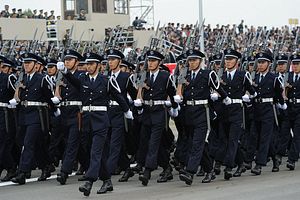On August 2, Japan’s Ministry of Defense (MoD) released its annual defense white paper, titled “Defense of Japan 2016,” approved by the Cabinet of Japanese Prime Minister Shinzo Abe, stressing the growing assertiveness and military buildup of the People’s Republic of China in the Asia-Pacific region.
Japan is, in particular, concerned over China’s land reclamation activities in the South China Sea and creeping militarization of the waters, which has triggered a regional arms race. “There has … been a noticeable trend among neighboring countries to modernize and reinforce their military capabilities and to intensify their military activities,” according to the MOD report.
Ever since 1989, China has consistently increased its defense budget by double-digit numbers, according to the Japanese MOD and embarked on a rapid modernization program: “China is currently carrying out [military] reforms (…) which some see as being the largest in the country’s history. (…) “Recently the reforms have taken place at a rapid pace.”
In the East and South China Seas, Beijing “continues to act in an assertive manner” and is “determined to accomplish its unilateral demands without compromise” and without regard to international norms, the paper notes. Furthermore, the defense white paper emphasizes that China’s disregard for international norms could result in “unintentional consequences.”
The 484-page report, 60 pages longer than last year’s defense white paper, lists various Chinese incursions into the waters around the Japanese-occupied Senkaku/Diaoyu Islands in the East China Sea claimed by China. Among other things, it highlights the entry of a Chinese warship into the contiguous zone around the Senkaku/Diaoyu Islands: “It was the first case by Chinese Naval combatant ship to enter that contiguous zone.”
The paper also reiterates that the Japan Air-Self Defense Force (JASDF) had to scramble its fighter jets 571 times during fiscal year 2015 to intercept Chinese military aircraft approaching or intruding Japanese airspace. As I noted in April 2016, “this number constitutes an all-time high since the defense ministry’s Joint Staff Office began to keep records in fiscal year 2001 and also marks a significant increase from 2014 with 464 sorties. Japan’s fiscal year ends in March.”
Next to devoting 50 pages to the Japan-U.S. alliance, the report also dedicates a separate section to the reinterpretation of Japan’s pacifist constitution by the Abe administration. The paper stresses the need for a more proactive approach towards Japanese security (The reinterpreted constitution now permits “collective self-defense” and limited military support of allies abroad):
The security environment surrounding Japan has become increasingly severe. In the midst of this, enforcing the legislation to ensure and contribute to peace and stability of the regional and international community is more important than ever.
Chinese state media has condemned Tokyo’s report, stating that it plays up the “’China threat’ and stirs up tensions in the region with a view to justifying Japan’s new security bills and finally moving closer to Abe administration’s long-held goal of revising the country’s pacifist constitution,” Xinhua news agency noted in a commentary. Xinhua also accused Japan of making “irresponsible remarks” on “China’s normal military growth and maritime activities.”
Other topics covered in the new defense white paper include North Korea’s nuclear development, Russia’s growing military power in the Far East, and the international combat against terrorism. It also mentions territorial disputes that Japan is involved in with South Korea and Russia: “The territorial issue over our sovereign territory of the Northern Territories and Takeshima still remains unresolved.” South Korea has lodged a complaint over Japan’s renewed claim of Takeshima (known in Korea as Dokdo), a small group of islets in the Sea of Japan claimed by both countries.






























